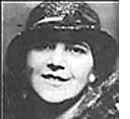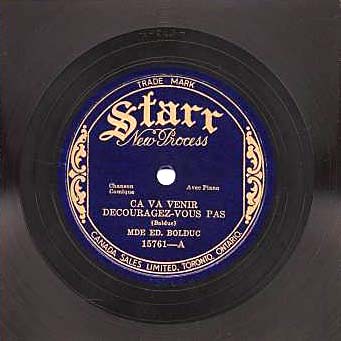Canadian Masters and their Works
Mary Bolduc – Ça va venir découragez-vous pas - 1930 

Biography by Robert Thérien
 No one could have predicted that Mary Travers would become one of the most influential singers and songwriters in Québec's history. Mary’s father was Irish and her mother was French-Canadian. She grew up in a large family in the remote fishing village of Newport, Gaspé. Mary barely knew how to read or write when she joined her step-sister in Montréal in 1907. Seven years later, she married Édouard Bolduc, a plumber, and the couple struggled to make ends meet. A woman of imposing stature (1m80, 85 kg), Mary Bolduc had an optimism that nothing could bring down. She learned some violin from her father and she taught herself to play the harmonica. Oftentimes, folk musicians would gather in the Bolduc's living room. Though everyone agreed she was quite good, a 35-year old mother of four was clearly not destined to be a singing star. But life had other plans...
No one could have predicted that Mary Travers would become one of the most influential singers and songwriters in Québec's history. Mary’s father was Irish and her mother was French-Canadian. She grew up in a large family in the remote fishing village of Newport, Gaspé. Mary barely knew how to read or write when she joined her step-sister in Montréal in 1907. Seven years later, she married Édouard Bolduc, a plumber, and the couple struggled to make ends meet. A woman of imposing stature (1m80, 85 kg), Mary Bolduc had an optimism that nothing could bring down. She learned some violin from her father and she taught herself to play the harmonica. Oftentimes, folk musicians would gather in the Bolduc's living room. Though everyone agreed she was quite good, a 35-year old mother of four was clearly not destined to be a singing star. But life had other plans...
Edouard Bolduc fell ill in 1927 and lost his job. In those days, social security was almost non-existent and Mary had to accept odd jobs at home. She was sometimes invited to sit in at “Les Veillées du bon vieux temps,” old time music shows that were held at the Monument National several times a year. In April 1929, Roméo Beaudry, vice-president of Starr Records, made her an offer she couldn’t refuse: four records a year, $25 for each song recorded (a side of a 78) and a one cent royalty fee for every record sold. But her first three records didn't do well. In October 1929, the Wall Street stock exchange crashed, causing a turmoil that would last ten years. But Beaudry believed strongly in Madame Bolduc, for he honoured his word and let her cut what could have been her last record. For the occasion, she wrote “La Cuisinière” (The Cook), her first complete song. It came out in 1929, just before Christmas, and became a big hit. No one really knows how many records were sold, some have exaggerated, but one thing is certain: Starr upgraded her contract to 17 records a year in 1930. Only big selling artists are awarded such a contract. With simple words and upbeat ditties, Mary Bolduc translated the joys and miseries of the poor people of her neighbourhood. In the tradition of oral culture, she "borrowed" her music lines from jigs and reels she heard. Most of her 84 songs were written over a three-year period.
By 1932, the economic crisis was taking its toll on the record industry, and to make matters worse, her producer Roméo Beaudry died of a heart attack in May. Up till then, Mary Bolduc had done no touring so she wouldn’t have to be away from her children. But with the diminishing record revenues, she had no choice. With the help of Jean Grimaldi, an Italian immigrant who would become a very influential producer of the era, she formed her own touring group with musicians and comedians. For five years, her “troupe” played to packed houses even in the most remote corners of Québec and toured several times in New England where half a million Québécois had migrated.
On June 25th 1937, while on tour near Rimouski, a car accident left Madame Bolduc with several fractures. While recuperating, she was diagnosed with cancer. The treatments, two operations and a liability suit resulting from the accident kept her out of the music scene for two years. After a partial recovery, she recorded her last four songs in early 1939 and found the energy to tour New England again for part of the summer. After some more treatments at the Radium Institute, while knowing it was a losing battle, she accepted a last tour of Abitibi and several more shows in Montréal right up to December 1940. She died on February 20th 1941.

Mary Bolduc was somewhat forgotten for almost 20 years. Then, a new generation discovered her songs. She became the subject of several books and films. All of her songs have now been reissued on CDs. In 1994, to celebrate her centennial, a Museum was inaugurated in her native village of Newport and Canada Post issued a commemorative stamp. Mary Bolduc was voted into the Canadian Songwriters Hall of Fame in 2003. Fame is indeed sticking to this working class girl who thought nothing of it during her life.
Links
http://www.labolduc.qc.ca/ehtm/e_frame.htm
http://www.collectionscanada.ca/gramophone/m2-1031-e.html